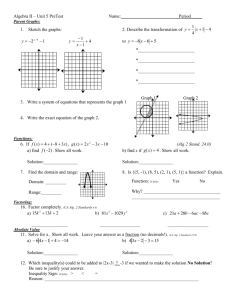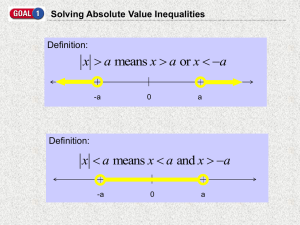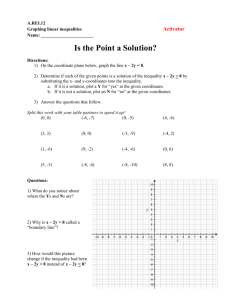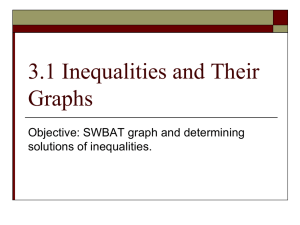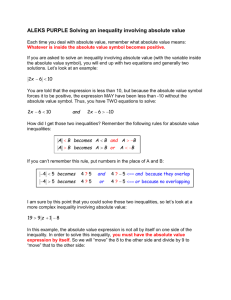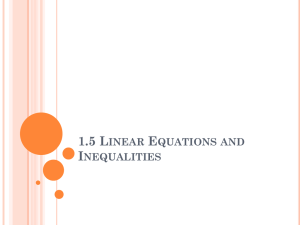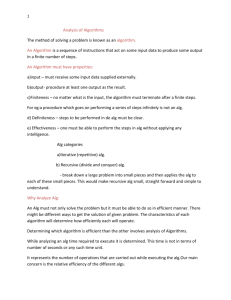6-A12 Handout: Absolute Value Graphs Alg 1H
advertisement
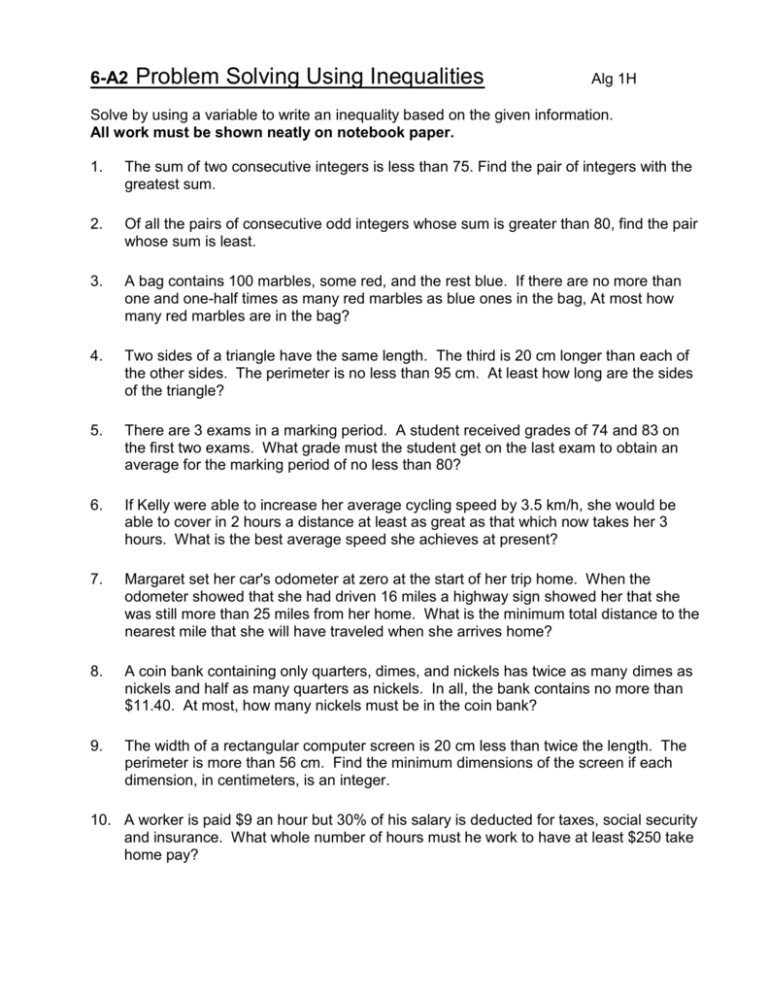
6-A2 Problem Solving Using Inequalities Alg 1H Solve by using a variable to write an inequality based on the given information. All work must be shown neatly on notebook paper. 1. The sum of two consecutive integers is less than 75. Find the pair of integers with the greatest sum. 2. Of all the pairs of consecutive odd integers whose sum is greater than 80, find the pair whose sum is least. 3. A bag contains 100 marbles, some red, and the rest blue. If there are no more than one and one-half times as many red marbles as blue ones in the bag, At most how many red marbles are in the bag? 4. Two sides of a triangle have the same length. The third is 20 cm longer than each of the other sides. The perimeter is no less than 95 cm. At least how long are the sides of the triangle? 5. There are 3 exams in a marking period. A student received grades of 74 and 83 on the first two exams. What grade must the student get on the last exam to obtain an average for the marking period of no less than 80? 6. If Kelly were able to increase her average cycling speed by 3.5 km/h, she would be able to cover in 2 hours a distance at least as great as that which now takes her 3 hours. What is the best average speed she achieves at present? 7. Margaret set her car's odometer at zero at the start of her trip home. When the odometer showed that she had driven 16 miles a highway sign showed her that she was still more than 25 miles from her home. What is the minimum total distance to the nearest mile that she will have traveled when she arrives home? 8. A coin bank containing only quarters, dimes, and nickels has twice as many dimes as nickels and half as many quarters as nickels. In all, the bank contains no more than $11.40. At most, how many nickels must be in the coin bank? 9. The width of a rectangular computer screen is 20 cm less than twice the length. The perimeter is more than 56 cm. Find the minimum dimensions of the screen if each dimension, in centimeters, is an integer. 10. A worker is paid $9 an hour but 30% of his salary is deducted for taxes, social security and insurance. What whole number of hours must he work to have at least $250 take home pay? 6-A3 (Lesson 6-4A) Solving Compound Inequalities Involving “And” Alg 1H Write an inequality that describes the graph. 1. 2. -4 0 3. 2 10 -7 Write an inequality that represents the statement. 4. x is greater than -6 and less than -1. 5. x is greater than or equal to 0 and less than 5. 6. x is greater than 1 and less than or equal to 8. 7. x is less than or equal to -2 and greater than -4. Solve the inequality. Then graph the solution. 8. 6 < x – 6 < 8 9. –5 < x – 3 < 6 10. 0 < x + 9 < 17 11. –14 < 7x < 21 12. –4 < 2x < 18 13. 4 < x – 7 < 15 14. –3 < 2x + 5 < 11 15. 7 < 3x – 8 < 19 16. 10 < 3x – 2 < 19 17. 0 < 12x + 6 < 18 18. –7 < 3 – x < 5 19. –20 < –5x < 0 20. 42 < –3x < 48 21. –5 < –6 – x < 3 22. –3 < 5 – 2x < 1 23. –7 < –1 – 6x < 11 24. –13 < 2 – 5x < –3 25. –44 < 1 – 9x < 55 3 6-A4 (Lesson 6-4B) Solving Compound Inequalities Involving “OR” Alg 1H Write an inequality that describes the graph. 1. 2. -4 4 3. -2 0 -1 Write an inequality that represents the set of numbers. 4. All real numbers less than -6 or greater than or equal to 2. 5. All real numbers greater than 7 or less than 0. 6. All real numbers less than 3 or greater than or equal to 10. 7. All real numbers greater than or equal to -2 or less than -14. Solve the inequality. Work all problems in your spiral. Then graph the solution. 8. x – 1 < –3 or x + 3 > 8 9. –12 > 8x or 4x > 6 10. x + 3 > 2 or 12x < –48 11. – 22 < 11x or 4 +x > 4 12. 7x < –42 or x + 5 > 3 13. 5 + x > 20 or 3x < –9 14. x – 4 < –12 or 2x > 12 15. –3x < 15 or 5 + x < –11 16. x + 10 < 10 or 3x – 7 > 5 17. –8x > 24 or 2x – 5 >17 18. 2x + 1 > 13 or –18 >7x + 3 19. 6 + 2x >20 or 8 + x < 0 20. 2x + 7 < 3 or 5x + 5 > 10 21. 3x + 8 > 17 or 2x + 5 < 7 22. 3x + 5 < –19 or 4x + 7 > –1 23. 1 – 5x < –14 or –3x – 2 > 7 24. 3x + 1 < 4 or 2x – 5 > 7 25. 2x + 3 < 1 or 3x – 5 > 1 1 6- A5 Solving Compound Inequalities Review Solve and graph your solution: 1. x < 0 and -x < 3 2. -x > 6 or x > 3 3. 5<x<7 4. x > 5 and x ≥ 7 5. x ≤ 5 or x > 7 6. x < 5 or x < 7 7. -5 ≥ x > -10 8. 7 < -x < 8 9. 2x + 1 ≥ 5 and x – 8 < 2 10. 2x > 8 or -3x ≤ 15 11. 2 > x + 3 > -8 12. 1 + 2x > 5 and 8 – x < 7 13. 2x + 1 < 7 or 2x + 1 > -7 14. -1 < 2x – 1 < 11 ` 15. -14 > 5x + 6 > -4 16. 2(x – 2) < 4 or 4 ≤ 2(x – 2) Alg 1H 6-A5 (continued) For the following problems, write let statements, a verbal model, an algebraic model, then solve. 1. Between them, Terry and Jane have 50 DVDs. If Jane has more than two-thirds as many DVDs as Terry, at least how many DVDs does Jane have? At most how many does Terry have? 2. A purse contains 20 coins, some of which are dimes and the rest nickels. Altogether, the coins are worth more than $1.40. At least how many dimes are in the purse? 3. Peter is 3 years older than Diane. Twenty years ago Peter was at least twice as old as Diane was. At most how old is Diane? 4. At 1 pm two trains traveling away from each other leave a town. One train averages 82 km/h and the other 74 km/h.. What is the earliest time of day that they will be at least 312 km apart? 5. A pair of consecutive integers has the property that 6 times the smaller is less than 5 times the greater. Find the greatest such integers. Challenge (optional): Aaron is three years older than Ben and Ben is three years older than Chris. The sum of their ages is between 12 and 21. How old are Aaron, Ben, and Chris if the product of their ages is 80? 6-A6 Solving Problems Involving Inequalities & Compound Inequalities Alg 1H Solve and write an inequality where appropriate. Work must be shown to receive credit. 1. Two integers are in a ratio of 5:8. If their sum is less than 100, what is the greatest possible value of the smaller integer? Hint: Let x = the common factor, therefore 5x = 1st #.and 8x = 2nd # 2. Of all pairs of consecutive even integers whose sum is greater than 200, find the pair whose sum is least. 3. A student received grades of 80, 85, and 76 on three exams. Find the minimum grade that the student must get on the fourth exam to obtain an average of no less than 84. 4. Two sides of a triangle have the same length. The third side is 15 cm longer than each of the equal sides. The perimeter is no less than 90 cm. What are the smallest possible lengths of the sides of the triangle? Solve each inequality and graph each solution if possible. 5. 0 < a + 5 < 7 _________ 7. –4 ≤ –3 + x ≤ 3 _________ 9. –5 ≤ 3m + 1 < 10 _________ 6. 2x ≤ 0 or x > 5 8. –2 ≤ 4 + x < 2 _________ _________ 10. –x > 0 or 2x > 8 _________ 11. y – 3 > 2y or y > 0 _________ 12. 3 – y < 6 or y > 2y – 3 __________ 6-A9 Absolute Value Practice Sheet Alg 1H Find the coordinates of each vertex. Solve each equation algebraically. 1. y x 3 14. 2. y x 1 15. 2 x 1 6 4 1 2 3x 2 7 y x8 16. 3 x 4 2 7 4. y x 3 10 17. 2 12 x 1 3 9 3. 5. y x 9 14 6. y 1 3 Solve each equation algebraically, then check your solutions graphically. x 1 2 7. y 3 x 6 3 Sketch the graph of each equation. 8. y x 3 9. y x 3 18. 1 4 x3 2 19. 4 x 8 5 20. 5x 2 3 11 21. 1 2 x3 2 3 10. y 2 x 6 11. y 12. 1 3 x2 y x 1 4 13. y 1 2 x3 6 Use this equation to answer # 22 – 27. 22. 23. 24. 25. 26. 27. Find the vertex Sketch the graph of the function Give the equation of the line of symmetry Does the function have a maximum or minimum value? What is it? Find the x-intercepts (solutions) algebraically Use this equation to answer # 28 – 33. 28. 29. 30. 31. y = ־2│x – 3│+ 5 y = 4│x + 2│– 6 Find the vertex Sketch the graph of the function Give the equation of the line of symmetry Does the function have a maximum or minimum value? 32. What is it? 33. Find the x-intercepts (solutions) algebraically Your work should have 12 graphs total. 6-A10 Absolute Value Inequalities Alg 1H Solve each absolute value inequality or equation and graph its solution. Work must be shown 1. |x|> 3 __________ 2. |x| ≤ 3 3. |x–2| =3 __________ 4. |x–2| > 3 __________ 5. |x–2| < 3 __________ 6. | 2–x|=5 __________ 7. –|x| < –3 __________ 8. |x+1|≥ 2 9. |x+3| < 4 __________ 10. | 2x – 1 | = 3 11. 2| x – 1 | = 3 __________ 12. | 2x | – 1 = 3 13. | 5x – 7 | ≥ 3 __________ 14. |2x – 1 | > 3 15. 1 – | 4 – x | ≤ –5 __________ __________ __________ __________ __________ __________ 16. | 3 – (x – 1) | < 5 __________ 6-A12 Handout: Absolute Value Graphs Alg 1H Find the vertex. Remember to write your answer as an ordered pair. 1. 5|x - 3| + 8 = y 2. | x | - 5 = y 3. y = - ¾ | x + 2| 4. Graph. Choose at least 4 points in addition to the vertex. y=-|x–2|-3 y vertex: _______ 10 9 8 7 6 5 4 3 2 1 -10 -9 -8 -7 -6 -5 -4 -3 -2 -1 -1 1 2 3 4 5 6 8 9 10 7 -2 -3 -4 -5 -6 -7 -8 -9 -10 Solve algebraically. Show all steps. 5. –3 | x + 5 | - 2 = -10 7. Solve and check graphically. |x–3|-2=4 6. | 2x – 3 | + 5 = 17 y 10 9 8 7 6 5 4 3 2 1 -10 -9 -8 -7 -6 -5 -4 -3 -2 -1 -1 -2 -3 -4 -5 -6 -7 -8 -9 -10 1 2 3 4 5 6 7 x 8 9 10 x 8. To be in the featherweight division in boxing you can be within 4 lbs. of the ideal weight of 122 lbs. Write an absolute value equation to model this and state the minimum and maximum values.
